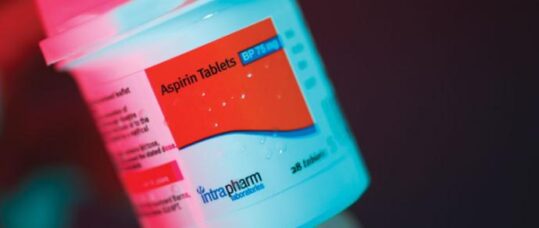Doorhandle conversation: ‘I’m taking aspirin every day for my heart’

Case study
A 54-year-old woman attends complaining of pain in her shoulder. She has no significant past medical history and is normally fit and well. Examination shows pain around the acromion process upon abduction of the shoulder. You refer her for physiotherapy and explain it may take a few weeks for that appointment to come through. You advise that she can take over-the-counter analgesics in the meantime, but she states that she takes aspirin every day ‘for her heart’ as she read that it was good for her.
There is good evidence to support a statistically significant reduction in non-fatal vascular events with the use of aspirin for primary prevention. While a 24% relative risk reduction for ischaemic stroke sounds good, the absolute reduction is very small – 10-20 for every 10,000 women treated in the Women’s Health Study.1 A meta-analysis of several studies also indicates that there is no significant reduction of vascular or all-cause mortality when using aspirin, and this lack of effect remains when analysis is done by sex, age or diabetes status.2 So a small reduction in ischaemic stroke is expected if all women such as her were to take aspirin, with no mortality gain.
However, the benefits of taking aspirin must be balanced against risk and aspirin is known to increase the risk of bleeding. While the relative risk increase of bleeding rates may seem high – 59% for gastrointestinal haemorrhage and 33% for intracranial bleeding – the absolute increase in bleeding rates remain modest – an increase of 26 per 10,000 people taking aspirin (split into 20 people with gastrointestinal bleeds and six with intracranial bleeds) compared with no aspirin. An awareness of baseline absolute risk is required to place relative risks into context, and bleeding risk is known to increase with age.
Aspirin has also recently been suggested to have beneficial effect in reducing cancer risk.3 Observational data support a modest reduction in cancer mortality (three per 10,000 people) and cancer incidence (22 per 10,000 people) in primary prevention clinical trials.4
Related Article: Prescribing in England to be led by a single national formulary
Guidelines recommend the following:
- NICE guidelines for hypertension – no advice on aspirin treatment.5
- NICE guidelines for type 2 diabetes – do not offer aspirin in the absence of cardiovascular disease.6
- European Society of Cardiology 2016 – antiplatelet therapy (eg with aspirin) is not recommended for people with diabetes who do not have cardiovascular disease.7
In line with the summarised evidence, it must be stressed that ‘aspirin is not licensed for the primary prevention of CVD’.8 Therefore, as a practising nurse in the UK, the best advice would be, based on current clinical evidence and UK guidelines, do not take over-the-counter aspirin for primary prevention of stroke, myocardial infarction or cancer.
Given the woman’s age, she would be entitled to an NHS check where her 10-year risk of cardiovascular disease can be calculated, using the QRISK3 calculator. The estimated risk is then stratified into three categories: >20% – low-dose aspirin advised; 10-20% – aspirin to be considered; <10% – aspirin not advised, focus on identifying and modifying lifestyle risk factors.8
If the score is 10% or more, some intervention would be recommended as per guidelines and focus should be to identify and modify lifestyle and vascular risk factors.
It is only after a fully informed discussion of risks and benefits a drug should be prescribed. It may include a lipid lowering drug only rather than aspirin. There is a delicate balance between the benefit gained by using aspirin for primary prevention of vascular events or cancer (very small in absolute terms) and the associated bleeding risk (very small in absolute terms), with no clear evidence of net benefit. In the absence of cardiovascular disease and a QRISK3 <10%, this lady should be advised to consider stopping her ongoing aspirin use.
Reena Patel is a practice nurse in Leicester
Dr Amit Mistri is a consultant in stroke medicine at University Hospitals of Leicester NHS Trust
Related Article: Lower stroke survival odds faced by people in poorer areas
References
1 2016 European guidelines on cardiovascular disease prevention in clinical practice. Eur Heart J. academic.oup.com/eurheartj/article/37/ 29/2315/1748952
2 Baigent C et al; Antithrombotic Trialists’ (ATT) Collaboration. Aspirin in the primary and secondary prevention of vascular disease: collaborative meta-analysis of individual participant data from randomised trials. Lancet. 2009; 373: 1849-60
3 Chubak J et al. Aspirin for the prevention of cancer incidence and mortality: systematic evidence reviews for the U.S. Preventive Services Task Force. Ann Intern Med. 2016; 164: 814-25
4 CKS 2018 (updated 2018) Antiplatelet treatment cks.nice.org.uk/antiplatelet-treatment#!scenario
5 NICE 2011 (updated 2016) Hypertension in adults: diagnosis and management nice.org.uk/guidance/cg127
Related Article: Be alert to pancreatitis in patients using GLP-1 weight-loss drugs
6 NICE 2018 Type 2 diabetes in adults: management nice.org.uk/guidance/ng28
7 European Society of Cardiology. Guidelines for the management of AF. Eur Heart J, 2016
8 Ridker PM et al. A randomized trial of low-dose aspirin in the primary prevention of cardiovascular disease in women. NEJM 2005; 352:1293-1304

See how our symptom tool can help you make better sense of patient presentations
Click here to search a symptom


Advice on this case of a woman who reports he is taking aspirin daily for heart health



